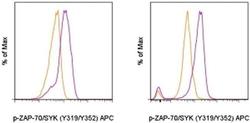Antibody data
- Antibody Data
- Antigen structure
- References [0]
- Comments [0]
- Validations
- Flow cytometry [1]
Submit
Validation data
Reference
Comment
Report error
- Product number
- 17-9006-41 - Provider product page

- Provider
- Invitrogen Antibodies
- Product name
- Anti-Phospho-ZAP70/Syk (Tyr319, Tyr352) Monoclonal Antibody (n3kobu5), APC, eBioscience™
- Antibody type
- Monoclonal
- Antigen
- Other
- Description
- Description: This n3kobu5 monoclonal antibody recognizes human and mouse zeta chain-associated protein of 70 kD (also known as ZAP-70) and spleen tyrosine kinase (also known as SYK) when phosphorylated on Y319 and Y352, respectively. ZAP-70 and SYK are members of the SYK protein tyrosine kinase (PTK) family that are phosphorylated and activated by Src family PTKs. ZAP-70/SYK Y319/Y352 are located in the so-called interdomain of ZAP-70/SYK (between the N-terminal dual SH2 domains and the C-terminal kinase domain). Phosphorylation of ZAP-70 Y319 by Lck is necessary for T cell receptor (TCR)-dependent association of ZAP-70 with Lck and phospholipase C gamma and subsequent activation of calcium-dependent and Ras signaling cascades. SYK Y352 phosphorylation by Fyn/Lyn is critical for propagation of B cell receptor (BCR) signaling and for B cell development. Specificity of this n3kobu5 clone was determined by ELISA, flow cytometry, and western blotting. Applications Reported: This n3kobu5 antibody has been reported for use in intracellular staining followed by flow cytometric analysis. Applications Tested: This n3kobu5 antibody has been pre-titrated and tested by intracellular staining followed by flow cytometric analysis of stimulated normal human peripheral blood cells. This can be used at 5 µL (0.03 µg) per test. A test is defined as the amount (µg) of antibody that will stain a cell sample in a final volume of 100 µL. Cell number should be determined empirically but can range from 10^5 to 10^8 cells/test. Staining Protocol: All protocols work well for this monoclonal antibody. Use of Protocol A: Two-step protocol: intracellular (cytoplasmic) proteins allows for the greatest flexibility for detection of surface and intracellular (cytoplasmic) proteins. Use of Protocol B: One-step protocol: intracellular (nuclear) proteins is recommended for staining of transcription factors in conjunction with surface and phosphorylated intracellular (cytoplasmic) proteins. Protocol C: Two-step protocol: Fixation/Methanol allows for the greatest discrimination of phospho-specific signaling between unstimulated and stimulated samples, but with limitations on the ability to stain specific surface proteins (refer to "Clone Performance Following Fixation/Permeabilization" located in the Best Protocols Section under the Resources tab online). All Protocols can be found in the Flow Cytometry Protocols: "Staining Intracellular Antigens for Flow Cytometry Protocol" located in the Best Protocols Section under the Resources tab online. Excitation: 633-647 nm; Emission: 660 nm; Laser: Red Laser. Filtration: 0.2 µm post-manufacturing filtered.
- Reactivity
- Human, Mouse
- Host
- Mouse
- Isotype
- IgG
- Antibody clone number
- n3kobu5
- Vial size
- 25 Tests
- Concentration
- 5 µL/Test
- Storage
- 4° C, store in dark, DO NOT FREEZE!
No comments: Submit comment
Supportive validation
- Submitted by
- Invitrogen Antibodies (provider)
- Main image

- Experimental details
- LEFT: Intracellular staining of whole human blood left unstimulated (orange histogram) or stimulated with Anti-Human CD3 Functional Grade Purified (Product # 16-0038-81) and goat anti-mouse IgG for 5 minutes (purple histogram) with Anti-Human/Mouse phospho-ZAP-70/SYK (Y319/Y352) APC. The 1-step Fix/Lyse Solution (Product # 00-5333-54) and Permeabilization Buffer (Product # 00-8333-56) and protocols were used for staining. Lymphocytes in the CD3+ gate were used for analysis. RIGHT: Intracellular staining of untreated (orange histogram) or 5-minute hydrogen peroxide-activated sodium pervanadate-treated (purple histogram) mouse spleen cells with Anti-Human/Mouse phospho-ZAP-70/SYK (Y319/Y352) APC using the Intracellular Fixation & Permeabilization Buffer Set (Product # 88-8824-00) and protocol. Lymphocytes in the CD3+ gate were used for analysis.
 Explore
Explore Validate
Validate Learn
Learn Flow cytometry
Flow cytometry